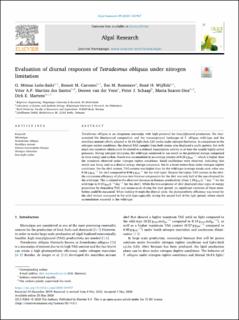| dc.contributor.author | Leon-Saiki, G. Mitsue | |
| dc.contributor.author | Carreres, Benoit M. | |
| dc.contributor.author | Remmers, Ilse M. | |
| dc.contributor.author | Wijffels, Rene Hubertus | |
| dc.contributor.author | dos Santos, Vitor A.P. Martins | |
| dc.contributor.author | van der Veen, Douwe | |
| dc.contributor.author | Schaap, Peter J. | |
| dc.contributor.author | Suarez-Diez, Maria | |
| dc.contributor.author | Martens, Dirk E. | |
| dc.date.accessioned | 2021-02-25T10:09:15Z | |
| dc.date.available | 2021-02-25T10:09:15Z | |
| dc.date.created | 2021-02-17T13:21:35Z | |
| dc.date.issued | 2020 | |
| dc.identifier.citation | Leon-Saiki, G. M., Carreres, B. M., Remmers, I. M., Wijffels, R. H., dos Santos, V. A. P. M., van der Veen, D., Schaap, P. J., Suarez-Diez, M. & Martens, D. E. (2020). Evaluation of diurnal responses of Tetradesmus obliquus under nitrogen limitation. Algal Research, 49: 101937. doi: | en_US |
| dc.identifier.issn | 2211-9264 | |
| dc.identifier.uri | https://hdl.handle.net/11250/2730325 | |
| dc.description.abstract | Tetradesmus obliquus is an oleaginous microalga with high potential for triacylglycerol production. We characterized the biochemical composition and the transcriptional landscape of T. obliquus wild-type and the starchless mutant (slm1), adapted to 16:8 h light dark (LD) cycles under nitrogen limitation. In comparison to the nitrogen replete conditions, the diurnal RNA samples from both strains also displayed a cyclic pattern, but with much less variation which could be related to a reduced transcription activity in at least the usually highly active processes. During nitrogen limitation, the wild-type continued to use starch as the preferred storage compound to store energy and carbon. Starch was accumulated to an average content of 0.25 g·gDW−1, which is higher than the maximum observed under nitrogen replete conditions. Small oscillations were observed, indicating that starch was being used as a diurnal energy storage compound, but to a lesser extent than under nitrogen replete conditions. For the slm1 mutant, TAG content was higher than for the wild-type (average steady state value was 0.26 g·gDW−1 for slm1 compared to 0.06 g·gDW−1 for the wild-type). Despite the higher TAG content in the slm1, the conversion efficiency of photons into biomass components for the slm1 was only half of the one obtained for the wild-type. This is related to the observed decrease in biomass productivity (from 1.29 gDW·L−1·day−1 for the wild-type to 0.52 gDW·L−1·day−1 for the slm1). While the transcriptome of slm1 displayed clear signs of energy generation by degrading TAG and amino-acids during the dark period, no significant variation of these metabolites could be measured. When looking through the diurnal cycle, the photosynthetic efficiency was lower for the slm1 mutant compared to the wild-type especially during the second half of the light period, where starch accumulation occurred in the wild-type. | en_US |
| dc.language.iso | eng | en_US |
| dc.publisher | Elsevier | en_US |
| dc.rights | Navngivelse 4.0 Internasjonal | * |
| dc.rights.uri | http://creativecommons.org/licenses/by/4.0/deed.no | * |
| dc.title | Evaluation of diurnal responses of Tetradesmus obliquus under nitrogen limitation | en_US |
| dc.type | Peer reviewed | en_US |
| dc.type | Journal article | en_US |
| dc.description.version | publishedVersion | en_US |
| dc.rights.holder | © 2020 The Author(s) | en_US |
| dc.subject.nsi | VDP::Matematikk og Naturvitenskap: 400::Zoologiske og botaniske fag: 480::Plantefysiologi: 492 | en_US |
| dc.subject.nsi | VDP::Matematikk og Naturvitenskap: 400::Basale biofag: 470::Molekylærbiologi: 473 | en_US |
| dc.source.pagenumber | 17 | en_US |
| dc.source.volume | 49 | en_US |
| dc.source.journal | Algal Research | en_US |
| dc.identifier.doi | 10.1016/j.algal.2020.101937 | |
| dc.identifier.cristin | 1890897 | |
| dc.description.localcode | Paid Open Access | en_US |
| dc.source.articlenumber | 101937 | en_US |

